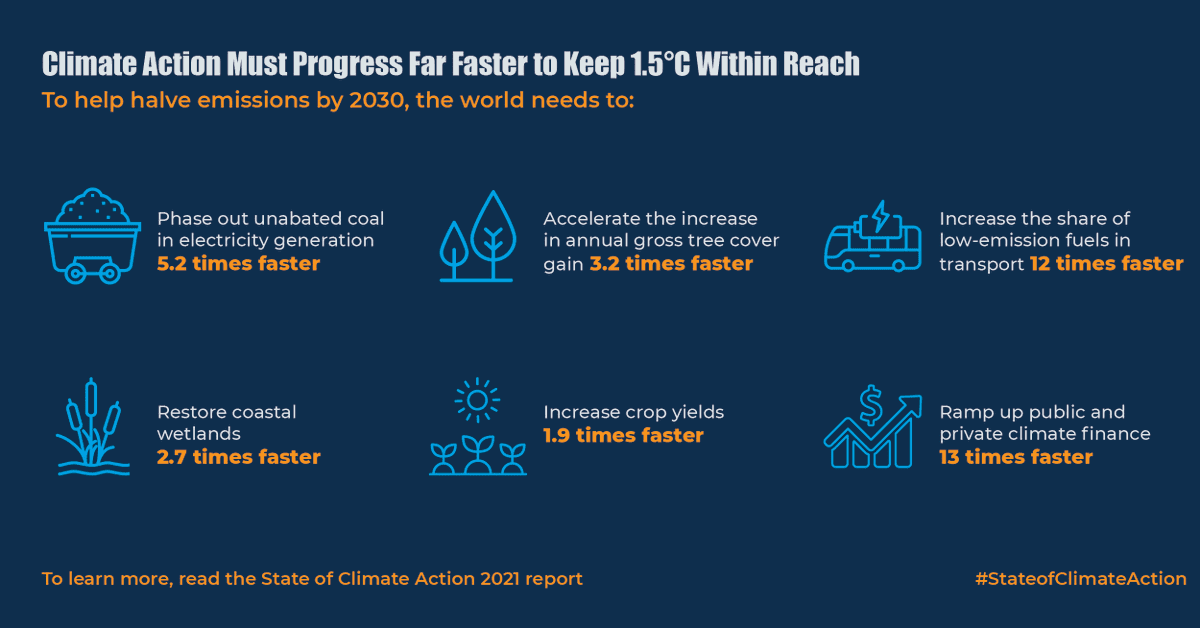Introduction
The Climate Action Tracker (CAT) State of Climate Action Report, issued in partnership with the United Nations High-Level Climate Change Champions, the World Resources Institute, and other organizations, presents a comprehensive evaluation of the global gap in climate action. This yearly study assesses the work of the world's most polluting systems to combat climate change. In this piece, we will look at the report's major features and results, throwing light on the importance of increasing climate action globally.
Global Greenhouse Gas Emissions:
The State of Climate Action Report reveals a staggering figure that demands urgent attention - the total global greenhouse gas emissions in 2019 reached a significant 58.5 gigatonnes of CO2 equivalent. This statistic highlights the critical need for immediate action to combat climate change. The sheer magnitude of these emissions underscores the scale of the problem we face as a global community. Without swift and decisive measures to reduce greenhouse gas emissions, the consequences for our planet and future generations could be dire. This data serves as a wake-up call, emphasizing the pressing need to transition to cleaner and more sustainable energy sources, implement robust emission reduction strategies, and foster global collaboration to mitigate the impacts of climate change. The urgency cannot be overstated; we must act now to secure a sustainable and livable future for all.
The Climate Action Gap:
The research illustrates the significant gap between current efforts and the 2030 objectives. To meet these targets, climate action must be significantly accelerated. One example of such acceleration is the phase-out of coal power generation, which must happen six times quicker than it is now. This data emphasizes the importance of implementing transformative reforms across several industries in order to successfully address climate change.
Breakthrough Agenda:
In contrast to the information presented in the original article, the Breakthrough Agenda Report was produced by the International Energy Agency, the International Renewable Energy Agency, and the UN Climate Change High-Level Champions. This report was required during the UN Climate Change Conference COP26 in November 2021. The Breakthrough Agenda aspires to unify activities and coordinate investments across major sectors responsible for almost 60% of global greenhouse gas emissions. These industries include power, road transportation, steel, hydrogen, and agriculture. The Breakthrough Agenda encompasses more than two-thirds of the global economy, including significant participants such as the G7, China, and India. Its goal is to foster collaboration and hasten the transition to a low-carbon society.
Greenhouse Gas Bulletin:
In spite of the fact that the Greenhouse Gas Bulletin is an annual report, it is published by the World Meteorological Organization (WMO) rather than the UN's World Meteorological Organization. WMO is the United Nations specialized agency in charge of meteorology, operational hydrology, and associated geophysical sciences. According to the report's core conclusions, atmospheric levels of the three major greenhouse gases (carbon dioxide, methane, and nitrous oxide) hit record highs in 2021. These increases are the consequence of both natural and human forces. Furthermore, the analysis predicts a 10.6% increase in emissions by 2030 compared to 2010, emphasizing the critical need for comprehensive climate action to stop this alarming trend.
Conclusion
The State of Climate Action Report presents a thorough review of global climate action and emphasizes the critical need for expanded climate change initiatives. With overall global greenhouse gas emissions approaching dangerous levels, it is critical to expedite activities and shift to more sustainable practices across several industries. Initiatives such as the Breakthrough Agenda seek to synchronize activities and investments in key sectors that account for a large amount of global emissions. The Greenhouse Gas Bulletin emphasizes the importance of taking rapid action to cut emissions and minimize the effects of climate change. We can strive towards a more sustainable and resilient future for our planet by recognizing the problems and possibilities mentioned in these publications.
Read more👉 - know about microplastics














.png)

0 Comments